8 Steps to calculating after tax cash flow
This article guides you through the procedures for creating an after-tax cash flow analysis and how to use it in property valuation. The rental house unit is the foundation for the computations here.
The analysis findings depend on choosing an appropriate rate to discount the after-tax cash flows to their present value; thus, it must be carefully considered.
The cash flows themselves shed light on the investment's suitability; therefore, it is essential to be aware of the after-tax cash flow analysis's assumptions.
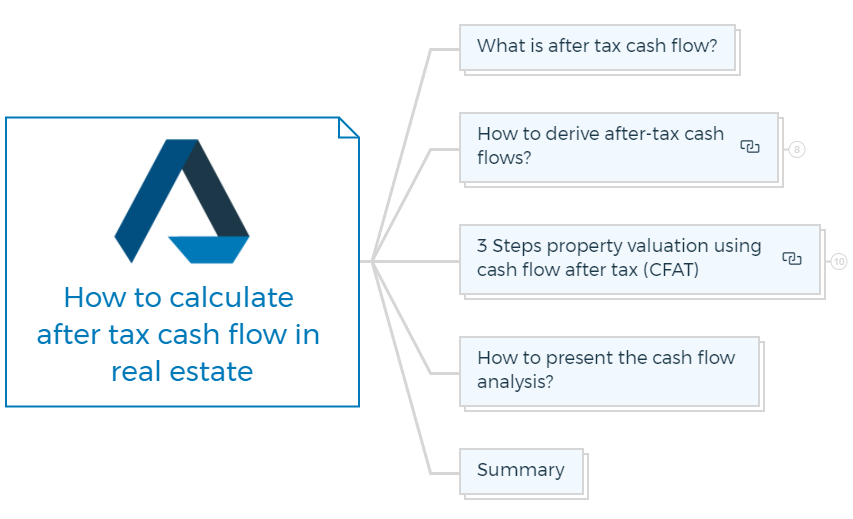
What is after tax cash flow?
After tax cash flow is the net cash flow of a company after taxes have been paid. This metric is used to measure a company's profitability and is a key drivers); for many financial decisions made by investors and management. After tax cash flow can be positive or negative, and is typically expressed as a dollar amount.
Let’s dive in and understand several steps to calculating the after tax cash flow of any property.
How to derive after-tax cash flows?
The primary goals of laying out cash flows are demonstrating a property's probable income and calculating fair prices or return measures.
In light of the anticipated risks, the investor or analyst can determine whether the internal rate of return from the cash flow, including the initial investment, is high enough to warrant buying the property.
Use the following steps to estimate the cash flows from property investment:
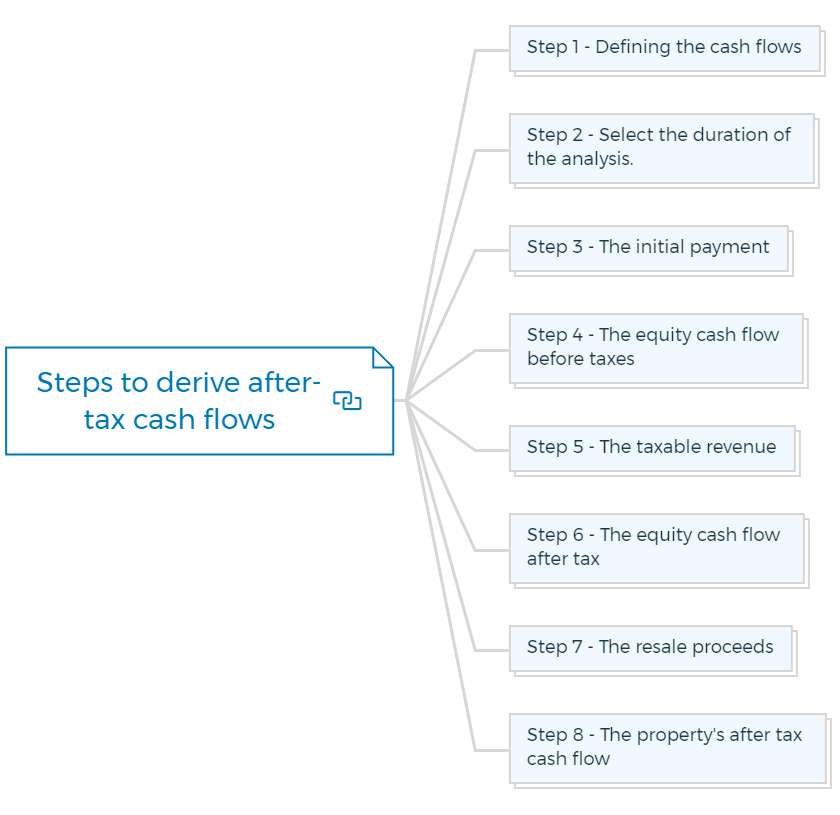
Step 1 - Defining the cash flows
There are several ways to define cash flows, but the four methods shown in the table below are the most popular for real estate investors. It is important not to mix up these different cash flows and what the analysis of each cash flow means.
Alternative Cash Flows

- The property's cash flow before taxes is independent of the investor's borrowing decision or tax status. This makes it possible to appraise the property without knowing who the buyer will be, and it is frequently used to support market valuations of assets that generate income.
- After subtracting predicted income tax and capital gains tax, the cash flow to the property after taxes is calculated. Utilising this cash flow, one can evaluate after-tax leverage. Property funds may discount this cash flow at their weighted average cost of capital.
- The most explicit of these cash flows is the after-tax equity cash flow analysis, which discounts property revenue after considering mortgage repayments, income taxes, and capital gains taxes.
Discounting equity cash flows after taxes is helpful in property evaluation, especially for private investors who frequently depend on the advantages of borrowing and tax shelters.
- The after-tax equity cash flows are typically derived by calculating and displaying the property and equity cash flows before taxes.
Step 2 - Select the duration of the analysis.
Once the estimated cash flows have been chosen, a suitable time range for the study is selected. How long into the future the cash flows will be predicted is the first choice.
After the "holding period," an estimated resale or residual value is required. The timing of the cash flows, often known as their frequency, is the second decision.
Both judgments are mostly driven by the availability of data, the likelihood of forecast accuracy, and practicality.
The first financial commitment to the plan would mark the start of the analysis for real estate development. Usually, it would conclude with the sale of the finished construction.
The analysis is typically divided into months or quarters depending on the overall development length and the cost projections' accuracy and precision.
The analysis would start with purchasing a property that has been improved. Depending on the investment objectives, it would either expire when the property is anticipated to be sold or assume a notional sale after five or ten years.
Rarely is the analysis longer than ten years, even if the buyer has no plans to sell at that time. This is due to several factors, including the difficulty in predicting cash flows this far in the future and the minimal impact that distant receipts have on current value.
Long-term institutional investors, such as superannuation funds and life companies, occasionally extend cash flow calculations to a 15-year holding period, but this may not contribute much to the analysis.
Another option is to continue the cash flow analysis until the forecasted net income stabilises. It may occur when rentals reach the midpoint of their subsequent cycle or when occupancy in a new building reaches its long-term projected average.
On rare occasions, the cash flow analysis might be postponed until a significant alteration or interruption in the income stream, like the expiration of a lease or an anticipated renovation.
According to the financial convention, all income receivable during the term is treated as if received at the end. However, most computer programmes and Australian standards treat every amount received throughout each period as if received at the start.
Step 3 - The initial payment
The monetary outflow incurred while purchasing an income-producing property is the initial outlay.
The initial outlay typically consists of the purchase price, any necessary initial repairs or modifications to make the property tenable, and the acquisition fees (including stamp duty), less any borrowed funds, net of any loan establishment costs.
The initial outlay calculation for residential property is as follows -
Initial Outlay Calculation
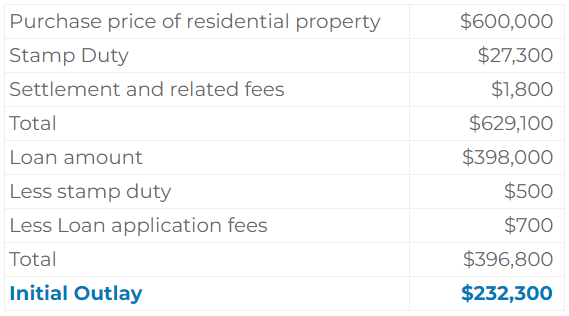
It may be required to precisely calculate the acquisition expenses later if they are first calculated as a proportion of the purchase price. Each state has its own stamp duty system, which is progressive and has a varied percentage of the purchase price depending on the price.
Most states use settlement agents for simple property transfers, and they often collect fees based on a published scale in addition to ancillary fees or "disbursements."
Buying a rental home may also include additional expenses like building inspection fees. Engineers and other experts, such as land surveyors or tax experts, may be hired to purchase medium-sized or big commercial buildings. Their costs could total up to 1% of the purchase price.
Often referred to as "period 0" (zero) of the cash flow, the initial outlay is an outflow at the beginning of the first period of the cash flow analysis.
Step 4 - The equity cash flow before taxes
Net (rental) income less loan payments equals equity cash flow before taxes. The rent due less necessary vacancy allowance and any expenses the landlord must pay for the property determines the net revenue from the property for each year of the intended holding period.
The recent history of vacancies and bad debts for the property and the anticipated market conditions during the holding period will determine the vacancy allowance.
Many contracts allow the landlord to deduct "net rent" from the tenant(s) and part or all construction expenses and income taxes. It is crucial that the net income accurately reflects the landlord's rental income following the deduction of all recurring statutory charges and operating costs.
To calculate the "property cash flows before tax," any capital costs required during the holding term should be subtracted from (or added to) the net income.
When capital spending is neglected, cash flows are inflated because it is frequently necessary to keep a building appealing to tenants.
In most cases, the property cash flows before taxes and the net income are the same.
The loan interest and servicing charges are deducted from the net income. The loan terms are used to determine the payments.
For loans that amortise, payments can be computed using spreadsheets, calculators, or financial formulas; however, for loans that are interest-only, payments are simply the interest rate per period multiplied by the loan amount.
To calculate the equity cash flows before tax, subtract the loan service fees that may have been incurred throughout each period.
It may be more appropriate to use different growth rates for rentals and operating costs and to allow for growth rates that reflect altering market conditions in each period of the cash flow analysis to estimate the cash flows for future periods.
Similarly, unless the investor plans to take out a fixed rate loan, each period's loan payments should account for the likelihood of interest rate adjustments.
The table below calculates the equity cash flows for the residential property's first two years.
- The change in gross income (Row 2) estimates the second year's income based on a percentage growth rate applied to the gross income of the first year.
- The vacancy allowance (Row 4) subtracted from the gross revenue each year is calculated by multiplying the gross income by the vacancy percentage (Row 3).
- The change in property charges (Row 7) is a percentage growth rate applied to the first year's statutory charges (Row 5) and operating expenses (Row 6) to estimate the second year's property expenses.
- The net (rental) income is calculated by subtracting the vacancy allowance, statutory charges, and running costs from the gross income (Row 8).
Equity cash flow before tax calculation
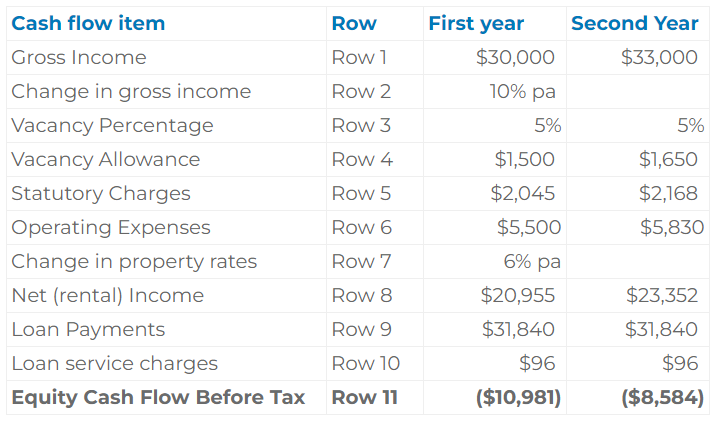
The interest-only loan payments for a year on a $398,000 mortgage at an annual interest rate of 8% come to $31,840. (Row 9). Loan payments and loan servicing costs (Row 10) are deducted from the net income to calculate the equity cash flow before taxes (Row 11).
The bottom row demonstrates that although the loss in the second year will be less severe, the equity cash flows for the first two years will be negative. The investor needs to find cash from other sources to cover a portion of the loan payments.
Step 5 - The taxable revenue
You can calculate the property's taxable income as the net income less any tax deductions for depreciation and other allowances, the interest component of mortgage installments, and an annual percentage of loan establishment fees.
It depends on the assumption that all building expenses are tax-deductible. However, while they may appear as operating expenses in the owner's accounts and may be recouped from tenants, capital expenditures and funds placed in sinking funds to cover future liabilities are not tax-deductible. To determine the taxable income, they need to be adjusted.
The taxable income from the home unit in the ongoing example is calculated for the first two years in the table below.
A $2,400 annual capital (or building) allowance is allowed for each holding period's five years.
For this example, it is assumed that the entire plant ($31,827) will have a practical life of 15 years. This will result in a deduction of $4,244 in the first year at the diminishing value rate of 13.33% pa and $3,678 in the second year.
The entire interest-only loan payment ($31,840 annually), as well as the loan service fee and a percentage of the loan establishment costs, are all tax deductible. Since only the interest is tax deductible, the interest component of amortizing loans must be distinguished from principal repayment.
Taxable Income
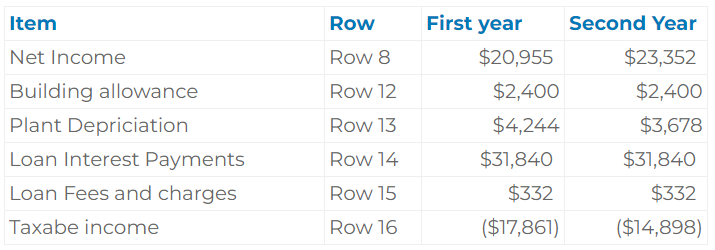
A negative taxable income (Row 16) indicates that the property's assessable income is less than the owner's tax deductions. Property tax loss decreases as rental income rises and plant depreciation deductions diminish.
Step 6 - The equity cash flow after tax
The income tax owed is subtracted from the equity cash flow before tax to arrive at the equity cash flow after tax for each year. The amount of income tax due is typically calculated by multiplying the taxable income by the investor's marginal tax rate.
The marginal rate is the amount the investor would pay (or avoid paying) on any additional taxable income or tax losses the property generates.
The tax that will be due (or saved), assuming the investor pays taxes on a graduated basis as individuals do, will be the difference between the investor's tax burden with and without the property included in the annual tax return.
Some of the more complex computer models do, in fact, more precisely determine the tax liability from real estate investments.
In this example, a marginal tax rate is used for an investor earning $80,000 a year. If most of this income is taxable, it will be subject to a tax rate of 30% (assuming).
The investor will save tax at the rate of 31.5 percent because the property is anticipated to result in tax losses.
After deducting the tax due (Row 17) from the equity cash flow before tax, the after-tax equity cash flow (Row 18) for the first two years is displayed in the table below (Row 11).
Equity cash flow After tax

This tax loss may lower the owner's other taxable income in that year if the taxable income is negative. However, the tax loss is carried forward and might lower taxable income in subsequent years if the owner does not have enough taxable income that year.
Analysis of after-tax cash flows often assumes that investors have enough additional taxable income to take advantage of the tax losses produced by the asset.
The cash flow before taxes is therefore increased if the tax payable is negative. When it comes to this property's financial losses before taxes, the tax that was saved offsets them.
Step 7 - The resale proceeds
The investor presumes to sell the property and settle any outstanding debt and taxes on capital gains within the analysis's final term. The final intermediate cash flow includes the resale proceeds.
The resale proceeds are the expected selling price less the costs of sale, the outstanding loan, any fees to pay off the loan, and any capital gains tax.
You can calculate the resale price by multiplying the current price or value by a growth factor; typically, the compound growth rate during the holding term is used.
The alternative is to calculate the resale price by dividing the anticipated net income in the year following the sale by a resale yield. This strategy also assures that the income growth and the capital value increase are consistent.
In reality, the resale price is estimated using the net income immediately following the sale because this is the revenue that a buyer would consider.
The net income following the sales and the "reversions" at that time is "capitalized" by some computer software for discounted cash flow analysis of commercial assets.
Interim after tax cash flows
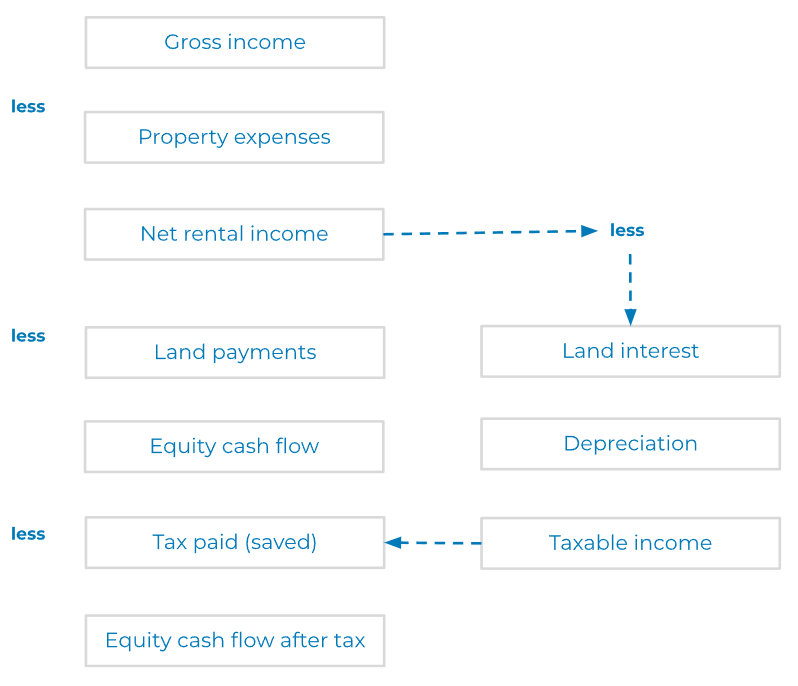
The selling expenses, which include transfer and real estate agent commissions, lower the resale price. A percentage of the resale price is typically used to express the selling costs.
The percentage of selling price taken up by these fees is smaller at higher prices and would be slightly variable in each state due to the real estate agent's commissions being on a sliding scale.
While selling for $250,000, the resale expenses would be around 4%; selling for $1,000,000 would be around 2%.
The remaining loan sum and any fees associated with paying off the loan are subtracted. The loan's terms determine the prepayment penalty in full. The taxable income in the year of the sale would be decreased by these fees, which are tax deductible.
In this case, the $398,000 that was borrowed is the remaining balance of the interest-only loan. Any fees are disregarded as the five-year interest-only loan would be coming to an end. They would be small costs, like deleting the charge from the title.
Resale proceed after tax calculation
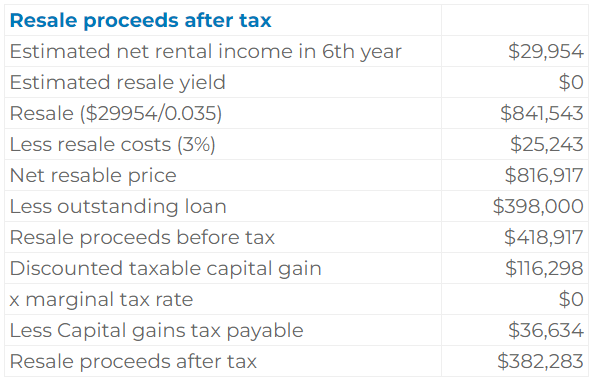
The resale proceeds after tax are calculated by estimating and subtracting any expected capital gains that would be taxable from the selling price.
The after-tax interim cash flow from the final year of the holding period is combined with the after-tax resale proceeds to display the after-tax equity cash flows in the timeline.
Resale proceeds after tax cash flow
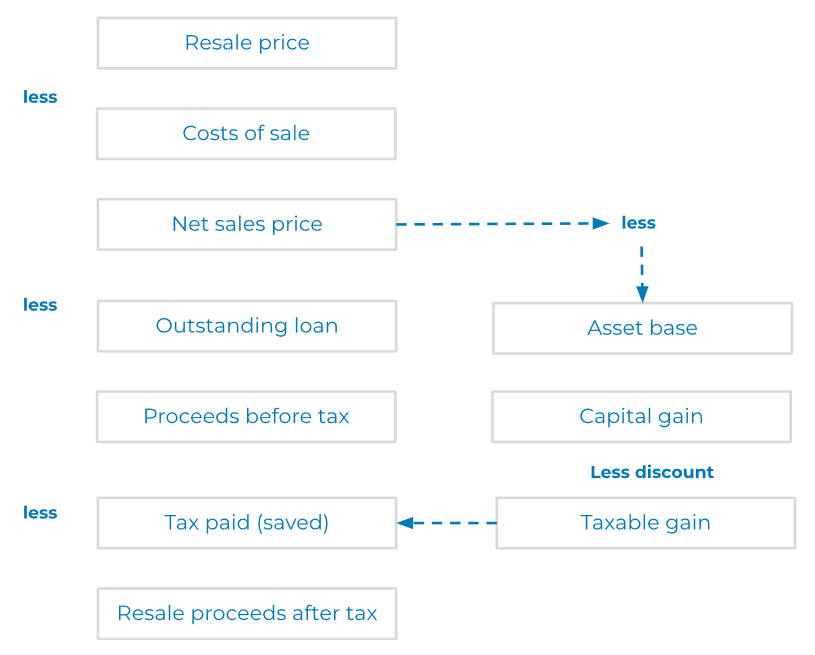
Most private investors are eager to maximize their tax benefits and take on significant debt to purchase real estate properties. These investors can use the equity cash flows after taxes to inform their choices for whether to buy the property, how much to pay and how much debt they should take on.
Step 8 - The property's after tax cash flow
Private investors are less likely to compute these than tax-paying businesses and property funds. These businesses and funds with the weighted average cost of capital after taxes can utilize the property cash flows.
The property's after-tax cash flow is determined as the property's pre-tax cash flows less the tax obligation as if the property had been purchased outright. The initial investment is equal to the purchase price and the acquisition costs.
When there are no loan-related tax deductions, the interim property cash flows after taxes equal the property cash flows before taxes minus the tax liability. The property before tax cash flow is the net rental revenue if no capital investment is anticipated over the five-year holding term.
The net rental income less the depreciation allowances, ignoring any tax deductions for the loan, is the taxable income. Taxable income is multiplied by the marginal tax rate of 31.5 per cent to determine the amount of tax due.
The net income less the tax due makes up the intermediate property after tax cash flow.
3 Steps property valuation using cash flow after tax (CFAT)
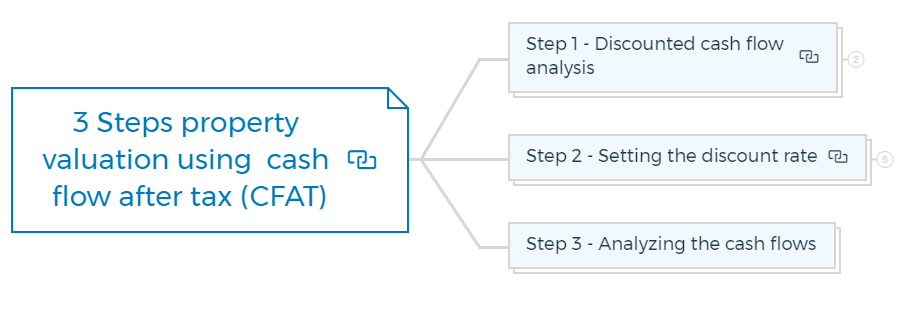
Step 1 - Discounted cash flow analysis

Equity cash flow after tax
After estimating the equity cash flow after tax during the holding period, the return is computed. Future cash flows are discounted to their present value to compare with the initial outlay.
According to the annual equity cash flow after tax shown in diagram below, the table calculates the net present value of those cash flows at a 9 percent annual discount rate.
Interim property cash flow after tax

The investor's needed return on equity after taxes should be used as the discount rate.
Net present value after tax
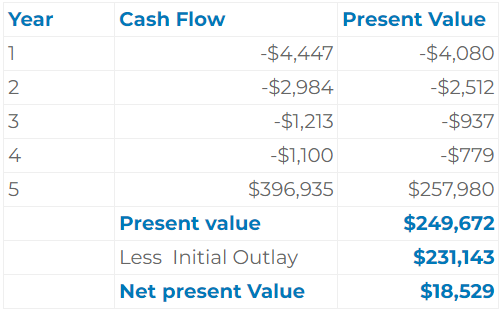
The net present value must be positive for the investment to be deemed acceptable. The investor should purchase the property at the current price with the proposed loan, according to the after-tax equity analysis's net present value of $18,529.
However, only if the predicted cash flows are realistic and the discount rate accurately reflects the risks to the cash flows. You can determine this cash flow's internal rate of return in a flash using a financial calculator or computer spreadsheet. It is 10.66 per cent annually.
Finding the discount rate at which the cash flow has a net present value of zero would entail performing numerous calculations to determine the internal rate of return through trial and error.
In this case, the internal rate of return is higher than the needed rate of 9 per cent annually, indicating that the investment should yield a sufficient return and that the investor should proceed with the purchase.
The net present value for various investments serves as a guide to how much more or less can be paid to achieve the desired rate of return.
If the price is changed, so are the acquisition costs, the number of capital gains tax due, and the loan-to-value ratio. It is quick and easy to determine the precise price change needed to match the internal rate of return to the necessary return on a computer spreadsheet.
Internal rates of return comparison
Understanding the sources of the return can be aided by comparing the internal rates of return on cash flows calculated on various bases.
The table below shows the internal rates of return for the four possible cash flows.

Comparing the returns on equity and real estate shows how much the return is increased by employing borrowed financing.
This example only shows a slight rise in the before-tax rate of return when borrowing roughly 65% of the price. Negative leverage could be caused by a slight decrease in net rent or a slight increase in loan interest rates.
If there is a significant risk, it will be demonstrated by testing the sensitivity of the property and equity returns to changes in rental growth and interest rates.
You can use the difference between the rates of return before and after taxes to estimate how taxes will affect an investment.
Even though the tax rate is 31.5 percent, the drop in the return on equity owing to tax is only 0.71 percent annually, from 11.37 to 10.66 per cent annually.
Because of the capital gains tax reduction, the depreciation and interest deductions, and the minimal difference, it is clear how little of the return is taxed.
The taxpayer's marginal tax rate decreases the before-tax rate of return once the entire return has been taxed. If the tax shelter, in this case, were removed, the before-tax equity return, which was 11.37 per cent, would drop to 7.79 per cent annually due to the 31.5 per cent tax rate.
The lower return demonstrates how crucial the tax shelter is. Some investors could be concerned that they are relying so heavily on tax shelters for their returns because they know that if their other taxable income decreases, it may be rejected or become ineffective.
Step 2 - Setting the discount rate
Because the discount rate significantly impacts whether the investment is accepted, it is essential to choose the correct rate when evaluating cash flows.
The rate of return necessary for the property acquisition to be appealing is known as the discount rate.
The needed, goal, and hurdle return rates are equivalent to the discount rate.
It's essential to understand that the discount rate relies on the type of cash flow being assessed: Is it the equity cash flow or the property? Is it before or after tax?
Given that taking on financial risk requires a higher return, discount rates for property cash flows are smaller than equity cash flows, assuming there is a loan.
Because taxpayers lose a portion of their investment and work income to taxes, discount rates for after-tax cash flows are lower than those for before-tax cash flows.
The following rules for choosing a discount rate are applicable to all four bases of cash flows, even though the necessary rates will vary.
The cost of capital and alternative investments are then used to calculate discount rates.
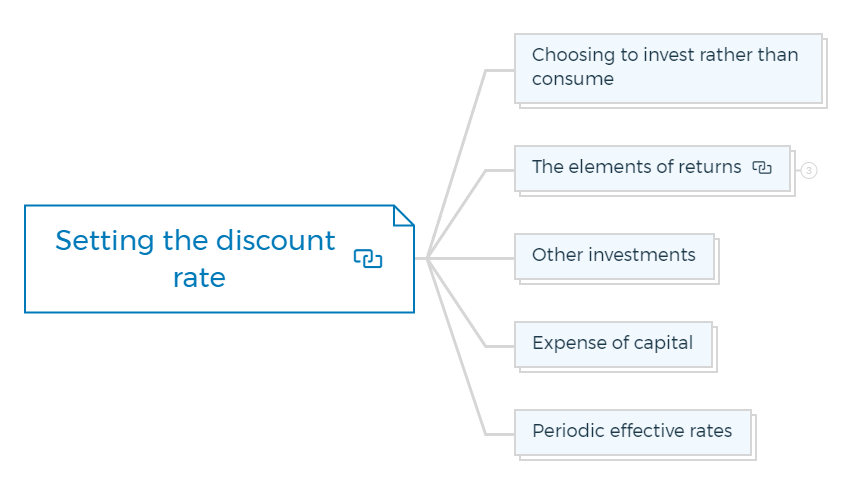
Choosing to invest rather than consume
Individuals choose how much of their income and capital to save rather than spend as a conceptual starting point. The decision between saving for future spending and engaging in current consumption affects discount rates across the economy.
Individuals' "propensity to save" is influenced by various factors, including their family responsibilities, age, and attitudes toward the possibility of running out of money later in life—likely in retirement.
Australia's mandatory superannuation contributions have raised the savings rate for most households while displacing some private savings. The tendency to save has long-term trends and cycles that affect rates of return on all investments.
The elements of returns
The discount rate represents three components of the return on investment.

1. Time value of money
Investors anticipate a return merely because they have given up the pleasure of spending their money by locking it up. The time value of money is another name for this.
It's a "real risk-free rate," the return you can expect from an investment without the risk of default, loss of capital if held to maturity, or change in interest payments, and without the danger that consumer price inflation will diminish the purchasing power of the capital or the income.
2. The inflation premium
Investors want to be protected against anticipated consumer price increases during the investment period. They demand a high enough investment return to account for inflation.
The return that would be required from assets for which there is no risk of default, loss of capital if held to maturity, or change in interest payments, such as federal government bonds, is made up of the time value of money and the inflation premium.
These bonds are frequently referred to as "risk-free," but if the holders don't hold them until they mature, they run the risk of their resale value declining if interest rates rise in the interim.
Additionally, there is a chance that inflation will exceed the premium incorporated into the return. Since there is almost little risk that the government will miss a payment of interest or repayment, they are "default-free."
The actual rate of inflation that has been recorded and the predicted inflation that is included in needed rates of return are likely to alter at different times.
3. The risk premium
An allowance for anticipated risks is the third component of any property's needed return.
The risk premium is an additional percentage return that is factored into the discount rate to account for the unpredictability of the anticipated cash flow and any potential challenges with a speedy sale.
Several risk analysis techniques are now attempting to quantify these risks to improve the consistency of risk premiums. The risk premium in property analysis is still primarily speculative and challenging to prove.
By contrasting the typical yields on government bonds and typical real estate returns, one can get an indication of the extent of the risk premium that has been earned.
Real estate investors bidding on homes today might need a very different risk premium than those paid in the past.
Bringing the three elements together
Even though you can combine these three factors to estimate their total influence on investors' necessary returns, the equation below is more precise since these factors' effects compound.
Combining components
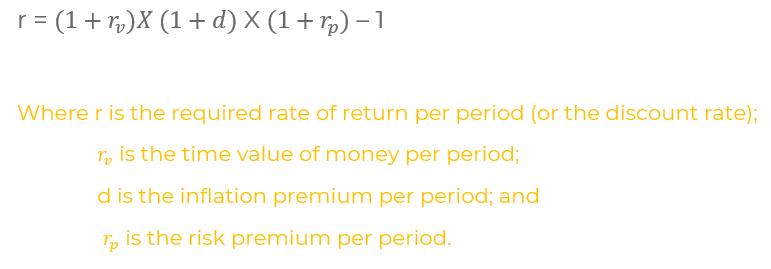
Other investments
The returns on other investments with comparable risk factors partly influence the discount rate. These options include investing the equity in further properties, possibly with varying degrees of borrowing, or any other ventures needing comparable outlays.
The constant growth model can be used to approximate the rate of return on alternative properties before taxes as follows:
Alternative investments
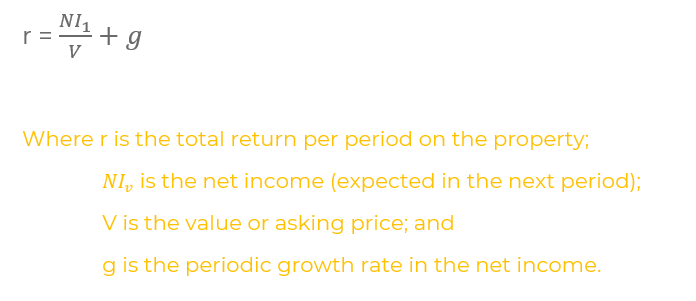
Since market expectations dictate rates of return on alternative properties, the growth rate used in this method must correspond to the growth anticipated by individuals involved in the market for this type of property.
The total return would be around 1% annually, less than before the purchase and sell charges due to the transaction costs.
Another option is to analyse other investments' cash flows to estimate their internal rates of return, but this can be overly complicated given the uncertainty of growth rates.
You can't effectively compare the returns available on properties in significantly different price ranges because the real estate markets are divided into value-based segments.
The investor's objectives and financial situation may indicate that other investments with different cash flow patterns should not be considered as alternatives since they are not acceptable.
Because borrowing decisions and tax status are individual to each investor, it is practically challenging to calculate a market-based rate of return on the equity cash flows after tax on alternative properties.
However, investors are expected to assess their potential rates of return from various assets and subject numerous potential acquisitions to an after-tax equity cash flow analysis.
Cost of capital
The cost of the capital used to buy the property establishes a minimum or hurdle rate that the anticipated cash flow must surpass.
The interest rate on money borrowed to buy a home can be considered the cost of money in its most basic form, even if this is the cost of debt rather than equity.
The loan interest rate suggests a minimal discount rate since it would be hard to justify buying any property if the cost of borrowing the money to buy it was higher than the return on the investment.
Compare the after-tax interest rate, the interest rate less the investor's marginal tax rate, to get the discount rate for the cash flows after taxes.
Use the recent capital issues to objectively establish the cost of capital, including debt and equity, for public property funds. The target debt-to-asset ratio most funds use to determine the proportions (or weights) of debt and equity.
The main factor affecting discount rates for property funds is frequently the weighted average cost of loan and equity capital.
As a loan is amortized, the tax shelter afforded to the equity cash flow decreases; thus, the benefits of the tax deductions on interest are only roughly reflected in the computation of the after-tax cost of borrowing.
Periodic effective rates
In most cases, discount rates are expressed as annual rates. When cash flow periods are shorter than a year, you must transform the discount rate into a periodic rate to get the present value.
There are two ways to go about doing this. You can convert the annual rate to a periodic rate by dividing it by the number of times in a year.
Lenders typically use this "nominal conversion" to determine monthly or more frequent mortgage payments. As an alternative, the periodic rate is determined as the rate that will match the annual stated rate after considering compound interest for each period.
This is how the "effective periodic rate" is calculated:
Effective periodic rate
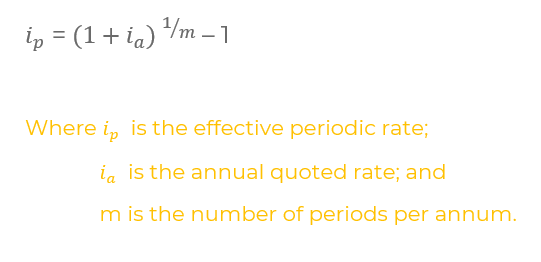
Most property investment analysis software employs the effective periodic rate when discounting cash flows that are more frequent than annual, which is the basis for conversion advised by the Australian Property Institute.
By discounting the yearly quoted rate for the number of periods expressed as years and parts of years, one can also determine the present value of cash flows at an effective periodic rate.
The equation below displays both techniques.
Present value of cash flow

Step 3 - Analyzing the cash flows
Viewing the anticipated annual profit or loss from the investment is one advantage of calculating cash flow. Many investors need cash from their properties at specified times and want the maximum return for a reasonable level of risk.
The "pattern" of the cash flows may indicate the suitability of the financing and the property.
Even though all five of the cash flows in the table below have the same internal rate of return (10.66 per cent annually), certain investors may find one or more of them to be completely unsuitable.
The first pattern is the after-tax equity cash flow from the under-reviewed residential unit. Only an investor who can increase their investment during the holding time to raise the terminal capital value would be acceptable for this cash flow.
This pattern is characteristic of vacant land maintained until it is ready for development with the costs of ownership needing interim cash withdrawals or typical of a highly geared real estate investment with a poor rental yield.
The excess mortgage interest over net rent for negatively geared properties may lead to cash losses (as well as tax losses) that necessitate additional payments from the owner. Negative gearing, for instance, is rarely a good strategy for retirees.

Some investors are solely interested in earning a return in the form of a capital gain and are unwilling to commit further funds after the initial investment. The second pattern is ideal for them.
They can roughly accomplish this by taking on a level of debt that requires total rental income to cover loan payments or by buying a property that generates a low rent while holding out for future redevelopment.
The third cash flow pattern would be favoured by investors looking for a moderate income to pay for personal or other needs in addition to capital growth. Many properties that generate income or other growth investments follow this trend.
In this case, the beginning rent and the growth in rent and capital value each contribute precisely half of the third cash flow's 10.66 per cent internal rate of return. By changing the loan's size, cash flows like these can be changed to offer more or less interim cash.
Some investors need a lot of cash throughout the time they are holding it. It could be done to cover personal expenses like retirement living costs or make up for other assets' financial losses.
When it comes to property funds, it can be to fulfill the expectations of unitholders for a specific payout or to meet accounting ratios.
The final two cash flow patterns are the most appropriate in these circumstances.
The fourth pattern is characteristic of interest-bearing deposits or a piece of real estate with no chance of increasing in value or income, with the initial investment being repaid at the end of the holding period.
A terminable property interest, such as a lease, could provide the fifth pattern. The consistency of the revenue is what makes it appealing.
The rate of return would not be impacted, for instance, if the first year's income was not received until the second year, but some owners may find this unacceptable risk.
Generally, it is preferable to receive a return in the form of spendable income instead of the same amount of return received through growth. It is due to the owner's ability to choose between reinvesting and using the money.
This is true as long as
- The return and cash flow are calculated after deducting taxes.
- Income and growth are seen as equally risky.
- There are no obstacles to reinvesting the revenue from the early years at the same level of return as the property demonstrates.
Riskier cash flows are anticipated to exhibit minimal interim income because unanticipated events could make the cash flow negative.
An after-tax equity cash flow analysis can also be used to determine whether various methods of financing the purchase of an asset with an income stream, such as:
- If interest-only, fully amortizing, partially amortizing, or "low start" loan repayments have a significant impact on the return or cash flow.
- If tax losses must be carried forward until the asset generates taxable revenue or if they can be recovered in the year they are incurred.
- The degree to which changes in mortgage interest rates or prepayment penalties affect the after-tax equity return.
- If purchasing the property at a higher price is justified by vendor financing with a favorable interest rate or other terms.
An after-tax equity cash flow model offers insights into the return, cash flow sufficiency, and risks of the purchase and its financing. You can also use it to assess any revenue stream or financing package.
How to present the cash flow analysis?
Poorly presented results from discounted cash flow analyses might not be helpful to real estate investors in making judgments.
The analyst must be able to clearly present the calculations and give recommendations, regardless of whether the investor is an individual buying a residential property or an institution buying a multi-tenanted commercial real estate such as a shopping center or office tower.
The property and financing report will include text and tables. The sophistication and aims of the client(s), the complexity of the income stream, and the type of advice sought will all affect the form and style of each report.
Before the discounted cash flow analysis results are presented, utilise the following checklist as a guide.
- Were the investor's objectives and circumstances outlined?
- The context and justifications for the analysis should be explained, even if it is an internal report (for an investment fund, for instance). This demonstrates that the issue at hand is comprehended.
- Has the analysis's conceptual framework been described?
- A brief explanation of the cash flow length, the intervals, and whether the emphasis is on the equity or property cash flows before or after tax is helpful at the outset.
- Were the projections, estimations, and assumptions identified and supported?
The report should separate the cash flow factors based on a supported opinion from the facts. It can be done by shading in estimate cells in the main cash flow tables and showing in separate tables rental growth per period, estimated leasing incentives planned for each year, vacancy rates each year, and other significant assumptions.
A summary table with a moderately giant print that fits on one sheet of A4 paper is one strategy. The reader should have no trouble understanding how all of the detailed tables' figures were incorporated into the summary table.
Has the decision regarding the discount rate and return measure(s) been explained?
You must justify the rate used to determine present values if the client has not provided the discount rate, and the proper return measures must be shown.
Given the cash flow's riskiness and the alternatives' performance, the analyst must generally comment on its sufficiency if only the internal rate of return from the cash flow is shown.
As part of the suggestions or results from the discounted cash flow analysis, the return(s) should be highlighted in the summary table, and their relevance should be discussed.
Is there a crystal-clear suggestion that addresses the brief?
Although there is frequently no clear conclusion that can be derived from the cash flows, analysts shouldn't be afraid to give the client well-reasoned advice.
Summary
The predicted net rental income can be subtracted from the loan repayments and tax liability to provide an after-tax equity cash flow for each year of the holding period.
The resale proceeds are calculated by deducting the outstanding loan balance and any capital gains taxes from the estimated resale price. The proceeds then increase the cash flow in the final year from the sale.
When the equity cash flows are discounted to their present value, it may be determined by -
- Whether the investment can be expected to generate a sufficient return after taxes, considering borrowing
- The reasonable price for the property.
For private investors, discount rates are primarily dependent on alternative investments, ideally ones with comparable risk. The rates are, if necessary, subjectively changed to reflect the level of risk.
You can compare the discount rate to the cost of capital, calculated using the after-tax interest rate on the loan, and to the needed return components, which include the time value of money, the inflation premium, and the risk premium.
One advantage of outlining equity cash flows is that it allows investors to assess if the timing of inflows and outflows is appropriate for their investment goals.
It's important to remember that after-tax cash flow analysis involves assumptions regarding how cash and taxable losses should be handled.
Make sure the cash flow tables and findings are presented clearly and convincingly.
Know your numbers and control any property profit with the Property Development Feasibility suite.
FAQs

